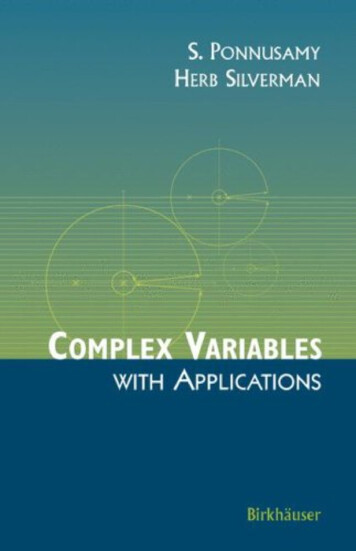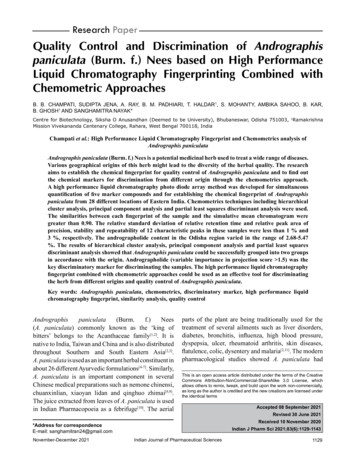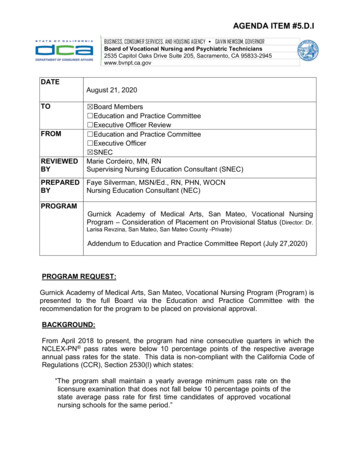
Transcription
S. PonnusamyHerb SilvermanComplex Variableswith ApplicationsBirkhäuserBoston Basel Berlin
S. PonnusamyIndian Institute of Technology, MadrasDepartment of MathematicsChennai, 600 036IndiaHerb SilvermanCollege of CharlestonDepartment of MathematicsCharleston, SC 29424U.S.A.Cover design by Alex Gerasev.Mathematics Subject Classification (2000): 11A06, 11M41, 30-XX, 32-XX (primary); 26Axx, 40Axx,26Bxx, 33Bxx, 26Cxx, 28Cxx, 31Axx, 35Axx, 37F10, 45E05, 76M40 (secondary)Library of Congress Control Number: 2006927602ISBN-10: 0-8176-4457-1ISBN-13: 978-0-8176-4457-4eISBN: 0-8176-4513-6Printed on acid-free paper.c 2006 Birkhäuser Boston All rights reserved. This work may not be translated or copied in whole or in part without the written permission of the publisher (Birkhäuser Boston, c/o Springer Science Business Media LLC, 233Spring Street, New York, NY 10013, USA), except for brief excerpts in connection with reviews orscholarly analysis. Use in connection with any form of information storage and retrieval, electronicadaptation, computer software, or by similar or dissimilar methodology now known or hereafter developed is forbidden.The use in this publication of trade names, trademarks, service marks and similar terms, even if theyare not identified as such, is not to be taken as an expression of opinion as to whether or not they aresubject to proprietary rights.Printed in the United States of America.987654321www.birkhauser.com(TXQ/MP)
To my father, Saminathan Pillai—S. PonnusamyTo my wife, Sharon Fratepietro—Herb Silverman
PrefaceThe student, who seems to be engulfed in our culture of specialization, tooquickly feels the necessity to establish an “area” of special interest. In keepingwith this spirit, academic bureaucracy has often forced us into a compartmentalization of courses, which pretend that linear algebra is disjoint frommodern algebra, that probability and statistics can easily be separated, andeven that advanced calculus does not build from elementary calculus.This book is written from the point of view that there is an interdependence between real and complex variables that should be explored at every opportunity. Sometimes we will discuss a concept in real variables andthen generalize to one in complex variables. Other times we will begin witha problem in complex variables and reduce it to one in real variables. Bothmethods—generalization and specialization—are worthy of careful consideration.We expect “complex” numbers to be difficult to comprehend and “imaginary” units to be shrouded in mystery. Hopefully, by staying close to thereal field, we shall overcome this regrettable terminology that has been thrustupon us. The authors wish to create a spiraling effect that will first enablethe reader to draw from his or her knowledge of advanced calculus in order todemystify complex variables, and then use this newly acquired understandingof complex variables to master some of the elements of advanced calculus.We will also compare, whenever possible, the analytic and geometric character of a concept. This naturally leads us to a discussion of “rigor”. Thecurrent trend seems to be that anything analytic is rigorous and anythinggeometric is not. This dichotomy moves some authors to strive for “rigor” atthe expense of rich geometric meaning, and other authors to endeavor to be“intuitive” by discussing a concept geometrically without shedding any analytic light on it. Rigor, as the authors see it, is useful only insofar as it clarifiesrather than confounds. For this reason, geometry will be utilized to illustrateanalytic concepts, and analysis will be employed to unravel geometric notions,without regard to which approach is the more rigorous.
viiiPrefaceSometimes, in an attempt to motivate, a discussion precedes a theorem.Sometimes, in an attempt to illuminate, remarks about key steps and possibleimplications follow a theorem. No apologies are made for this lack of tersenesssurrounding difficult theorems. While brevity may be the soul of wit, it is notthe soul of insight into delicate mathematical concepts. In recognition of theprimary importance of observing relationships between different approaches,some theorems are proved in several different ways. In this book, travelingquickly to the frontiers of mathematical knowledge plays a secondary role tothe careful examination of the road taken and alternative routes that lead tothe same destination.A word should be said about the questions at the end of each section. Theauthors feel deeply that mathematics should be questioned—not only for itsinternal logic and consistency, but for the reasons we are led where we are.Does the conclusion seem “reasonable”? Did we expect it? Did the steps seemnatural or artificial? Can we re-prove the result a different way? Can we stateintuitively what we have proved? Can we draw a picture?1“Questions”, as used at the end of each section, cannot easily be categorized. Some questions are simple and some are quite challenging; some arespecific and some are vague; some have one possible answer and some havemany; some are concerned with what has been proved and some foreshadowwhat will be proved. Do all these questions have anything in common? Yes.They are all meant to help the student think, understand, create, and question. It is hoped that the questions will also be helpful to the teacher, whomay want to incorporate some of them into his or her lectures.Less need be said about the exercises at the end of each section becauseexercises have always received more favorable publicity than have questions.Very often the difference between a question and an exercise is a matter ofterminology. The abundance of exercises should help to give the student agood indication of how well the material in the section has been understood.The prerequisite is at least a shaky knowledge of advanced calculus. Thefirst nine chapters present a solid foundation for an introduction to complexvariables. The last four chapters go into more advanced topics in some detail,in order to provide the groundwork necessary for students who wish to pursuefurther the general theory of complex analysis.If this book is to be used as a one-semester course, Chapters 5, 6, 7,8, and 9 should constitute the core. Chapter 1 can be covered rapidly, andthe concepts in Chapter 2 need be introduced only when applicable in latterchapters. Chapter 3 may be omitted entirely, and the mapping properties inChapter 4 may be omitted.We wanted to write a mathematics book that omitted the word “trivial”.Unfortunately, the Riemann hypothesis, stated on the last page of the text,1For an excellent little book elaborating on the relationship between questioningand creative thinking, see G. Polya, How to Solve It, second edition, PrincetonUniversity press, Princeton, New Jersey, 1957.
Prefaceixcould not have been mentioned without invoking the standard terminologydealing with the trivial zeros of the Riemann zeta function. But the spirit, ifnot the letter, of this desire has been fulfilled. Detailed explanations, remarks,worked-out examples and insights are plentiful. The teacher should be able toleave sections for the student to read on his/her own; in fact, this book mightserve as a self-study text.A teacher’s manual containing more detailed hints and solutions to questions and exercises is available. The interested teacher may contact us bye-mail and receive a pdf version.We wish to express our thanks to the Center for Continuing Educationat the Indian Institute of Technology Madras, India, for its support in thepreparation of the manuscript.Finally, we thank Ann Kostant, Executive Editor, Birkhäuser, who hasbeen most helpful to the authors through her quick and efficient responsesthroughout the preparation of this manuscript.S. PonnusamyIIT Madras, IndiaJune 2005Herb SilvermanCollege of Charleston, USA
ContentsPreface . . . . . . . . . . . . . . . . . . . . . . . . . . . . . . . . . . . . . . . . . . . . . . . . . . . . . . . . vii1Algebraic and Geometric Preliminaries . . . . . . . . . . . . . . . . . . . . 11.1 The Complex Field . . . . . . . . . . . . . . . . . . . . . . . . . . . . . . . . . . . . . . 11.2 Rectangular Representation . . . . . . . . . . . . . . . . . . . . . . . . . . . . . . . 51.3 Polar Representation . . . . . . . . . . . . . . . . . . . . . . . . . . . . . . . . . . . . . 152Topological and Analytic Preliminaries . . . . . . . . . . . . . . . . . . . .2.1 Point Sets in the Plane . . . . . . . . . . . . . . . . . . . . . . . . . . . . . . . . . . .2.2 Sequences . . . . . . . . . . . . . . . . . . . . . . . . . . . . . . . . . . . . . . . . . . . . . .2.3 Compactness . . . . . . . . . . . . . . . . . . . . . . . . . . . . . . . . . . . . . . . . . . . .2.4 Stereographic Projection . . . . . . . . . . . . . . . . . . . . . . . . . . . . . . . . .2.5 Continuity . . . . . . . . . . . . . . . . . . . . . . . . . . . . . . . . . . . . . . . . . . . . . .2525323944483Bilinear Transformations and Mappings . . . . . . . . . . . . . . . . . . .3.1 Basic Mappings . . . . . . . . . . . . . . . . . . . . . . . . . . . . . . . . . . . . . . . . .3.2 Linear Fractional Transformations . . . . . . . . . . . . . . . . . . . . . . . . .3.3 Other Mappings . . . . . . . . . . . . . . . . . . . . . . . . . . . . . . . . . . . . . . . . .616166854Elementary Functions . . . . . . . . . . . . . . . . . . . . . . . . . . . . . . . . . . . . . 914.1 The Exponential Function . . . . . . . . . . . . . . . . . . . . . . . . . . . . . . . . 914.2 Mapping Properties . . . . . . . . . . . . . . . . . . . . . . . . . . . . . . . . . . . . . . 1004.3 The Logarithmic Function . . . . . . . . . . . . . . . . . . . . . . . . . . . . . . . . 1084.4 Complex Exponents . . . . . . . . . . . . . . . . . . . . . . . . . . . . . . . . . . . . . 1145Analytic Functions . . . . . . . . . . . . . . . . . . . . . . . . . . . . . . . . . . . . . . . . 1215.1 Cauchy–Riemann Equation . . . . . . . . . . . . . . . . . . . . . . . . . . . . . . . 1215.2 Analyticity . . . . . . . . . . . . . . . . . . . . . . . . . . . . . . . . . . . . . . . . . . . . . 1305.3 Harmonic Functions . . . . . . . . . . . . . . . . . . . . . . . . . . . . . . . . . . . . . 141
xiiContents6Power Series . . . . . . . . . . . . . . . . . . . . . . . . . . . . . . . . . . . . . . . . . . . . . . . 1536.1 Sequences Revisited . . . . . . . . . . . . . . . . . . . . . . . . . . . . . . . . . . . . . . 1536.2 Uniform Convergence . . . . . . . . . . . . . . . . . . . . . . . . . . . . . . . . . . . . 1646.3 Maclaurin and Taylor Series . . . . . . . . . . . . . . . . . . . . . . . . . . . . . . 1736.4 Operations on Power Series . . . . . . . . . . . . . . . . . . . . . . . . . . . . . . . 1867Complex Integration and Cauchy’s Theorem . . . . . . . . . . . . . . . 1957.1 Curves . . . . . . . . . . . . . . . . . . . . . . . . . . . . . . . . . . . . . . . . . . . . . . . . . 1957.2 Parameterizations . . . . . . . . . . . . . . . . . . . . . . . . . . . . . . . . . . . . . . . 2077.3 Line Integrals . . . . . . . . . . . . . . . . . . . . . . . . . . . . . . . . . . . . . . . . . . . 2177.4 Cauchy’s Theorem . . . . . . . . . . . . . . . . . . . . . . . . . . . . . . . . . . . . . . . 2268Applications of Cauchy’s Theorem . . . . . . . . . . . . . . . . . . . . . . . . . 2438.1 Cauchy’s Integral Formula . . . . . . . . . . . . . . . . . . . . . . . . . . . . . . . . 2438.2 Cauchy’s Inequality and Applications . . . . . . . . . . . . . . . . . . . . . . 2638.3 Maximum Modulus Theorem . . . . . . . . . . . . . . . . . . . . . . . . . . . . . 2759Laurent Series and the Residue Theorem . . . . . . . . . . . . . . . . . . 2859.1 Laurent Series . . . . . . . . . . . . . . . . . . . . . . . . . . . . . . . . . . . . . . . . . . 2859.2 Classification of Singularities . . . . . . . . . . . . . . . . . . . . . . . . . . . . . . 2939.3 Evaluation of Real Integrals . . . . . . . . . . . . . . . . . . . . . . . . . . . . . . 3089.4 Argument Principle . . . . . . . . . . . . . . . . . . . . . . . . . . . . . . . . . . . . . . 33110 Harmonic Functions . . . . . . . . . . . . . . . . . . . . . . . . . . . . . . . . . . . . . . . 34910.1 Comparison with Analytic Functions . . . . . . . . . . . . . . . . . . . . . . . 34910.2 Poisson Integral Formula . . . . . . . . . . . . . . . . . . . . . . . . . . . . . . . . . 35810.3 Positive Harmonic Functions . . . . . . . . . . . . . . . . . . . . . . . . . . . . . . 37111 Conformal Mapping and the Riemann Mapping Theorem . . 37911.1 Conformal Mappings . . . . . . . . . . . . . . . . . . . . . . . . . . . . . . . . . . . . . 37911.2 Normal Families . . . . . . . . . . . . . . . . . . . . . . . . . . . . . . . . . . . . . . . . . 39011.3 Riemann Mapping Theorem . . . . . . . . . . . . . . . . . . . . . . . . . . . . . . 39511.4 The Class S . . . . . . . . . . . . . . . . . . . . . . . . . . . . . . . . . . . . . . . . . . . . 40512 Entire and Meromorphic Functions . . . . . . . . . . . . . . . . . . . . . . . . 41112.1 Infinite Products . . . . . . . . . . . . . . . . . . . . . . . . . . . . . . . . . . . . . . . . 41112.2 Weierstrass’ Product Theorem . . . . . . . . . . . . . . . . . . . . . . . . . . . . 42212.3 Mittag-Leffler Theorem . . . . . . . . . . . . . . . . . . . . . . . . . . . . . . . . . . 43713 Analytic Continuation . . . . . . . . . . . . . . . . . . . . . . . . . . . . . . . . . . . . . 44513.1 Basic Concepts . . . . . . . . . . . . . . . . . . . . . . . . . . . . . . . . . . . . . . . . . . 44513.2 Special Functions . . . . . . . . . . . . . . . . . . . . . . . . . . . . . . . . . . . . . . . . 458References and Further Reading . . . . . . . . . . . . . . . . . . . . . . . . . . . . . . . 473Index of Special Notations . . . . . . . . . . . . . . . . . . . . . . . . . . . . . . . . . . . . . 475
ContentsxiiiIndex . . . . . . . . . . . . . . . . . . . . . . . . . . . . . . . . . . . . . . . . . . . . . . . . . . . . . . . . . . 479Hints for Selected Questions and Exercises . . . . . . . . . . . . . . . . . . . . 485
1Algebraic and Geometric PreliminariesThe mathematician Euler once said, “God made integers, all else is the workof man.” In this chapter, we have advanced in the evolutionary process tothe real number system. We partially characterize the real numbers and then,alas, find an imperfection. The quadratic equation x2 1 0 has no solution.A new day arrives, the complex number system is born. We view a complexnumber in several ways: as an element in a field, as a point in the plane, andas a two-dimensional vector. Each way is useful and in each way we see anunmistakable resemblance of the complex number system to its parent, thereal number system. The child seems superior to its parent in every way exceptone—it has no order. This sobering realization creates a new respect for thealmost discarded parent.The moral of this chapter is clear. As long as the child follows certainguidelines set down by its parent, it can move in new directions and teach usmany things that the parent never knew.1.1 The Complex FieldWe begin our study by giving a very brief motivation for the origin of complexnumbers. If all we knew were positive integers, then we could not solve theequation x 2 1. The introduction of negative integers enables us to obtaina solution. However, knowledge of every integer is not sufficient for solvingthe equation 2x 1 2. A solution to this equation requires the study ofrational numbers.While all linear equations with integers coefficients have rational solutions,there are some quadratics that do not. For instance, irrational numbers areneeded to solve x2 2 0. Going one step further, we can find quadraticequations that have no real (rational or irrational) solutions. The equationx2 1 0 has no real solutions because the square of any real numberis nonnegative. In order to solve this equation, we must “invent” a number
21 Algebraic and Geometric Preliminaries whose square is 1. This number, which we shall denote by i 1, is calledan imaginary unit.Our sense of logic rebels against just “making up” a number that solves aparticular equation. In order to place this whole discussion in a more rigoroussetting, we will define operations involving combinations of real numbers andimaginary units. These operations will be shown to conform, as much as possible, to the usual rules for the addition and multiplication of real numbers. Wemay express any ordered pair of real numbers (a, b) as the “complex number”a bior a ib.(1.1)The set of complex numbers is thus defined as the set of all ordered pairsof real numbers. The notion of equality and the operations of addition andmultiplication are defined as follows:1(a1 , b1 ) (a2 , b2 ) a1 a2 , b1 b2 ,(a1 , b1 ) (a2 , b2 ) (a1 a2 , b1 b2 ),(a1 , b1 )(a2 , b2 ) (a1 a2 b1 b2 , a1 b2 a2 b1 ).The definition for the multiplication is more natural than it appears to be,for if we denote the complex numbers of the form (1.1), multiply as we wouldreal numbers, and use the relation i2 1, we obtain(a1 ib1 )(a2 ib2 ) a1 a2 b1 b2 i(a1 b2 a2 b1 ).Several observations should be made at this point. First, note that the formaloperations for addition and multiplication of complex numbers do not dependon an imaginary number i. For instance, the relation i2 1 can be expressedas (0, 1)(0, 1) ( 1, 0). The symbol i has been introduced purely as a matterof notational convenience. Also, note that the order pair (a, 0) represents thereal number a, and that the relations(a, 0) (b, 0) (a b, 0)and(a, 0)(b, 0) (ab, 0)are, respectively, addition and multiplication of real numbers. Some of theessential properties of real numbers are as follows: Both the sum and productof real numbers are real numbers, and the order in which either operation isperformed may be reversed. That is, for real numbers a and b, we have thecommutative lawsa b b a and a · b b · a.(1.2)a (b c) (a b) c and a · (b · c) (a · b) · c,(1.3)The associative laws1The symbol stands for “if and only if” or “equivalent to.”
1.1 The Complex Field3and the distributive lawa · (b c) a · b a · c(1.4)also holds for all real numbers a, b, and c. The numbers 0 and 1 are, respectively, the additive and multiplicative identities. The additive inverse of a is a, and the multiplicative inverse of a ( 0) is the real number a 1 1/a.Stated more concisely, the real numbers form a field under the operations ofaddition and multiplication.Of course, the real numbers are not the only system that forms a field.The rational numbers are easily seen to satisfy the above conditions for afield. What is important in this chapter is that the complex numbers alsoform a field. The additive identity is (0, 0), and the additive inverse of (a, b)is ( a, b). The multiplicative inverse of (a, b) (0, 0) is ab., 2a2 b2a b2We leave the confirmation that the complex numbers satisfy all the axiomsfor a field as an exercise for the reader.The discerning math student should not be satisfied with the mere verification of a proof. He/she should also have a “feeling” as to why the proofworks. Did the reader ask why the multiplicative inverse of (a, b) might beexpected to be ab?, 2a2 b2a b2Let us go through a possible line of reasoning. If we write the inverse of(a, b) a bi as1,(a ib) 1 a ibthen we want to find a complex number c di such that1 c id.a ibBy cross multiplying, we obtain ac i2 bd i(ad bc) 1, or ac bd 1,ad bc 0.The solution to these simultaneous equation isc a2a, b2d a2b. b2Can the reader think of other reasons to suspect that
41 Algebraic and Geometric Preliminaries(a, b) 1 ab, ?a2 b2a2 b2Let z (x, y) be a complex number. Then x and y are called the real part ofz, Re z, and the imaginary part of z, Im z, respectively. Denote the set of realnumbers by R and the set of complex numbers by C. There is a one-to-onecorrespondence between R and a subset of C, represented by x (x, 0) forx R, which preserves the operations of addition and multiplication. Hencewe will use the real number x and the ordered pair (x, 0) interchangeably.We will also denote the ordered pair (0, 1) by i. Because a complex numberis an ordered pair of real numbers, we use the terms C R2 or C R Rinterchangeably. Thus R 0 is a subset of C consisting of the real numbers.As noted earlier, an advantage of the field C is that it contains a rootof z 2 1 0. In Chapter 8 we will show that any polynomial equationa0 a1 z · · · an z n 0 has a solution in C. But this extension from R toC is not without drawbacks. There is an important property of the real fieldthat the complex field lacks. If a R, then exactly one of the following istrue:a 0, a 0, a 0 (trichotomy).Furthermore, the sum and the product of two positive real numbers is positive(closure).A field with an order relation that satisfies the trichotomy law and thesetwo additional conditions is said to be ordered. In an ordered field, like thereal or rational numbers, we are furnished with a natural way to compare anytwo elements a and b. Either a is less than b (a b), or a is equal to b (a b),or a is greater than b (a b). Unfortunately, no such relation can be imposedon the complex numbers, for suppose the complex numbers are ordered; theneither i or i is positive. According to the closure rule, i2 ( i)2 1 isalso positive. But 1 must be negative if 1 is positive. However, this violatesthe closure rule because ( 1)2 1.To sum up, there is a complex field that contains a real field that contains arational field. There are advantages and disadvantages to studying each field.It is not our purpose here to state properties that uniquely determine eachfield, although this most certainly can be done.Questions 1.1.1. Can a field be finite?2. Can an ordered field be finite?3. Are there fields that properly contain the rationals and are properlycontained in the reals?4. When are two complex numbers z1 and z2 equal?5. What complex numbers may be added to or multiplied by the complexnumber a ib to obtain a real number?6. How can we separate the quotient of two complex numbers into its realand imaginary parts?
1.2 Rectangular Representation57. What can we say about the real part of the sum of the two complexnumbers? What about the product?8. What kind of implications are there in defining a complex number asan ordered pair?9. If a polynomial of degree n has at least one solution, can we say more?10. If we try to define an ordering of the complex numbers by saying that(a, b) (c, d) if a b and c d, what order properties are violated?11. Can any ordered field have a solution to x2 1 0?Exercises 1.2. 1. Show that the set of real numbers of the form a b 2, where a and bare rational, is an ordered field.2. If a and b are elements in a field, show that ab 0 if and only if eithera 0 or b 0.3. Suppose a and b are elements in an ordered field, with a b. Show thatthere are infinitely many elements between a and b.4. Find the values of(a) ( 2, 3)(4, 1)(b) (1 2i){3(2 i) 2(3 6i)}(c) (1 i)3(d) (1 i)4(e) (1 i)n (1 i)n .5. Express the following in the form x iy:(a) (1 i) 5 (c) eiπ/2 2eiπ/4a ib a ib (e)a ib a ib(g) (2 i)2 (2 i)2(b) (3 2i)/(1 i)(d) (1 i)eiπ/63 5i1 i(f) 7 i 4 3i(4 3i) 3 4i(h)3 i (j) ( 1 i 3)60 ( 3 i)2 (1 i)5 (l).( 3 i)4(ai40 i17 ), (a real) 1 i1 a2 ia (k), (a real)a i 1 a26. Show that 6 3 1 i 3 1 3 1 and 122(i)for all combinations of signs.7. For any integers k and n, show that in in 4k . How many distinctvalues can be assumed by in ?1.2 Rectangular RepresentationJust as a real number x may be represented by a point on a line, so may acomplex number z (x, y) be represented by a point in the plane (Figure 1.1).
61 Algebraic and Geometric Preliminariesyy0z (x, y ) x iyxxFigure 1.1. Cartesian representation of z in planeEach complex number corresponds to one and only one point. Thus theterms complex number and point in the plane are used interchangeably. Thex and y axes are referred to as the real axis and the imaginary axis, while thexy plane is called the complex plane or the z plane.There is yet another interpretation of the complex numbers. Each point(x, y) of the complex plane determines a two-dimensional vector (directed linesegment) from (0, 0), the initial point, to (x, y), the terminal point. Thus thecomplex number may be represented by a vector. This seems natural in thatthe definition chosen for addition of complex numbers corresponds to vectoraddition; that is,(x1 , y1 ) (x2 , y2 ) (x1 x2 , y1 y2 ).Geometrically, vector addition follows the so-called parallelogram rule, whichwe illustrate in Figure 1.2. From the point z1 , construct a vector equal inmagnitude and direction to the vector z2 . The terminal point is the vectorz1 z2 . Alternatively, if a vector equal in magnitude and direction to z1 isjoined to the vector z2 , the same terminal point is reached. This illustratesthe commutative property of vector addition. Note that the vector z1 z2is a diagonal of the parallelogram formed. What would the other diagonalrepresent?Figure 1.2. Illustration for parallelogram law
1.2 Rectangular Representation7Figure 1.3. Modulus of a complex number zBy the magnitude (length) of the vector (x, y) we mean the distance ofthe point z (x, y) from the origin. This distance is called the modulusor absolute value of the complex number z, and denoted by z ; its value is x2 y 2 . For each positive real number r, there are infinitely many distinctvalues (x, y) whose absolute value is r z , namely the points on the circlex2 y 2 r2 . Two of these points, (r, 0) and ( r, 0), are real numbers so thatthis definition agrees with the definition for the absolute value in the real field(see Figure 1.3).Note that, for z (x, y), x Re z z , y Im z z .The distance between any two points z1 (x1 , y1 ) and z2 (x2 , y2 ) is z2 z1 (x2 x1 )2 (y2 y1 )2 .The triangle inequalities z1 z2 z1 z2 , z1 z2 z1 z2 say, geometrically, that no side of a triangle is greater in length than thesum of the lengths of the other two sides, or less than the difference of thelengths of the other two sides (Figure 1.2). The algebraic verification of theseinequalities is left to the reader.Among all points whose absolute value is the same as that of z (x, y),there is one which plays a special role. The point (x, y) is called the conjugateof z and is denoted by z. If we view the real axis as a two-way mirror, then zis the mirror image of z (Figure 1.4).From the definitions we obtain the following properties of the conjugate:
81 Algebraic and Geometric PreliminariesFigure 1.4. Mirror image of complex numbers z1 z2 z 1 z 2 ,z1 z2 z 1 z 2 .(1.5)Some of the important relationships between a complex number z (x, y)and its conjugates are z z (2x, 0) 2Re z, z z (0, 2y) 2iIm z, (1.6) z z x2 y 2 , zz z 2 .The squared form of the absolute value in (1.6) is often the most workable.For example, to prove that the absolute value of the product of two complexnumbers is equal to the product of their absolute values, we write z1 z2 2 (z1 z2 )(z1 z2 ) (z1 z2 )(z 1 z 2 ) (z1 z 1 )(z2 z 2 ) ( z1 z2 )2 .Moreover, the conjugate furnishes us with a method of separating the inverseof a complex number into its real and imaginary parts:(a bi) 1 1aba bia bi· 2 2i. 222a bi a bia ba ba b2Equation of a line in C. Now we may rewrite the equation of a straightline in the plane, with the real and imaginary axes as axes of coordinates, as z zz z b c 0,ax by c 0, a, b, c R; i.e., a22i
1.2 Rectangular Representation9where at least one of a, b is nonzero. That is,(a ib)z (a ib)z 2c 0.Conversely, by retracing the steps above, we see thatαz βz γ 0(1.7)represents a straight line provided α β, α 0 and γ is real.Equation of a circle in C. A circle in C is the set of all point equidistantfrom a given point, the center. The standard equation of a circle in the xyplane with center at (a, b) and radius r 0 is (x a)2 (y b)2 r2 . If wetransform this by means of the substitution z x iy, z0 a ib, then wehave z z0 (x a) i(y b) so that(z z0 )(z z0 ) z z0 2 (x a)2 (y b)2 r2 .Therefore, the equation of the circle in the complex form with center z0 andradius r is z z0 r. In complex notation we may rewrite this aszz (zz 0 zz0 ) z0 z 0 r2 , i.e. zz 2Re [z(a ib)] a2 b2 r2 0,where z0 a ib. Thus, in general, writing a ib β and γ a2 b2 r2 ,we see thatα z 2 βz βz γ 0, i.e.z βα2 β 2 αγ,α2(1.8)represents a circle provided α, γ are real, α 0 and β 2 αγ 0.The formulas in (1.6) produce z1 z2 2 z1 2 2Re (z1 z 2 ) z2 2 .Also, for two complex numbers z1 and z2 , we have(i) 1 z 1 z2 2 z1 z2 2 (1 z1 z2 )2 ( z1 z2 )2 , since2L.H.S (1 z 1 z2 )(1 z1 z 2 ) (z1 z2 )(z 1 z 2 ) 1 (z 1 z2 z1 z 2 ) z1 z2 2 ( z1 2 z2 2 z1 z 2 z 1 z2 ) 1 z1 z2 2 ( z1 2 z2 2 ) (1 z1 2 )(1 z2 2 ) R.H.S.Further, it is also clear from (i) that if z1 1 and z2 1, then2L.H.S is to mean left-hand side and R.H.S is to mean right-hand side.(1.9)
101 Algebraic and Geometric Preliminaries z1 z2 1 z1 z 2 and if either z1 1 or z2 1, then z1 z2 1 z 1 z2 .(ii) z1 z2 2 z1 z2 2 2( z1 2 z2 2 ) ( Parallelogram identity ); for,L.H.S (z1 z2 )(z 1 z 2 ) (z1 z2 )(z 1 z 2 ) [ z1 2 (z1 z 2 z 1 z2 ) z2 2 ] [ z1 2 (z1 z 2 z 1 z2 ) z2 2 ] R.H.S.Example 1.3. Let us use the triangle inequality to find upper and lowerbounds for z 4 3z 1 1 w
Herb Silverman College of Charleston Department of Mathematics Charleston, SC 29424 U.S.A. Cover design by Alex Gerasev. . This book is written from the point of view that there is an interdepe










